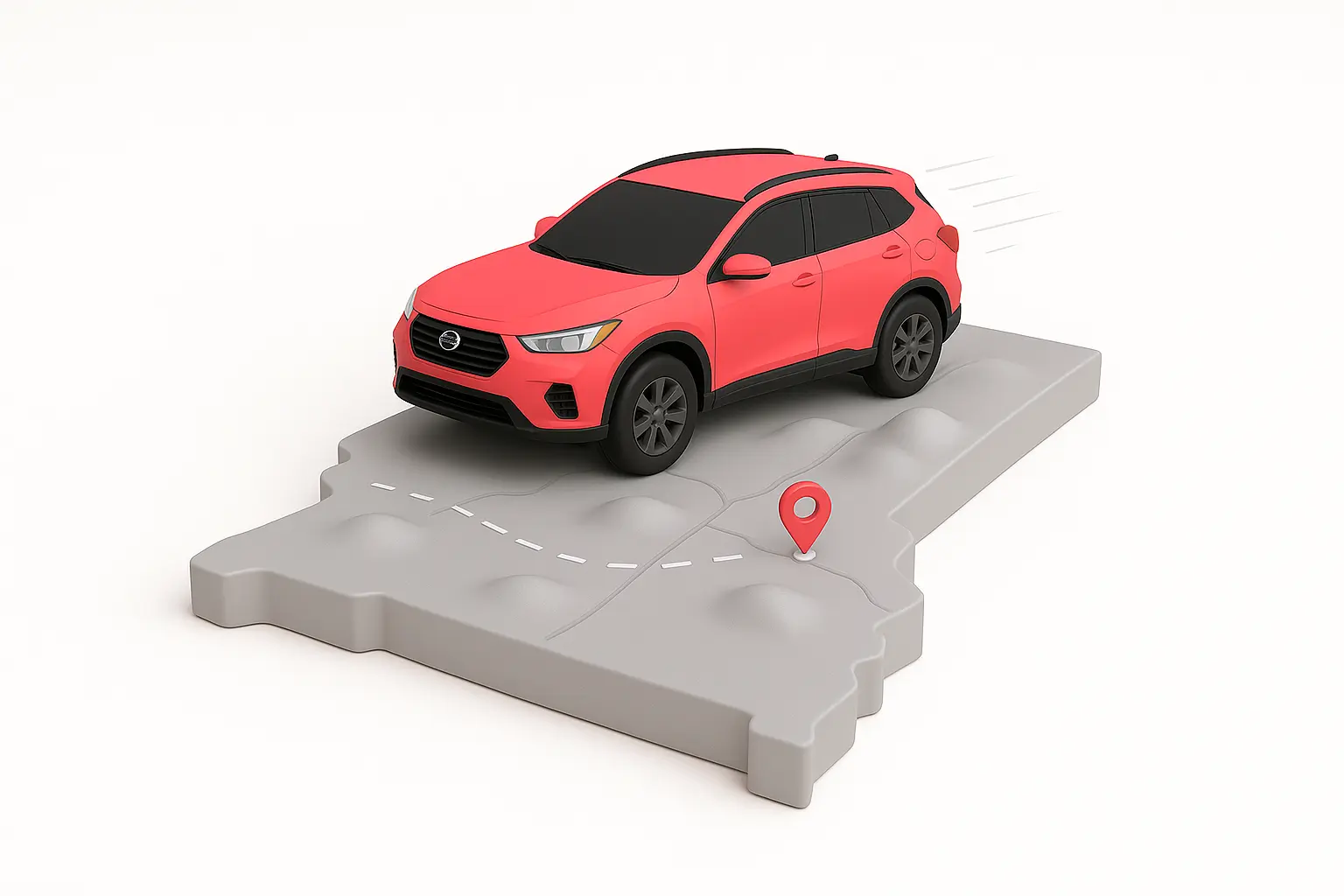Many V6 and V8 engines have two or more sensors, so replacing them all can increase the total cost.
Real customers Jerry helped
The price range for a camshaft position sensor replacement can vary based on your specific car, location, and parts used. But Jerry makes it easy to see what others are paying right now. Here are some examples of customers we’ve helped find the very best prices for their camshaft position sensor repairs.
Estimates are modeled based on real vehicle and location data; names have been changed. Actual prices will vary by shop, parts, and vehicle condition.
Cost breakdown: Why the price varies
Number of sensors:
Inline engines often have 1-2; V-type engines can have 2-4. The diagnostic trouble code tells you which one failed (e.g., Bank 2 Sensor B).
Location & access to the part:
The easier the valve cover is to reach, the less labor you pay—if it’s right on top at the front of the engine, it might only take about half an hour. If it’s tucked at the back of the engine or buried under other parts, the job can jump to roughly 1–2+ hours of labor.
Part quality:
For timing sensors, Original Equipment Manufacturer (OEM) or Tier-1 (Bosch/Denso/Delphi) is strongly recommended to avoid comebacks and signal noise.
Shop type and location:
Dealers typically charge more for parts and labor than independents. Nationally, labor rates vary widely.
Diagnostic fee & billing:
Many shops charge $120–$200 to diagnose and apply it to the repair if you proceed. Parts typically carry a 25–60% markup, which helps cover warranty handling. If you bring your own part, labor warranty may be reduced.
Jerry recommends: For timing sensors like a camshaft position sensor, Original Equipment Manufacturer (OEM) or Tier-1 (Bosch/Denso/Delphi) is strongly recommended to avoid comebacks and signal noise.
The repair explained: What is a camshaft position sensor?
A camshaft position sensor is a small electronic part that helps your engine “keep time.” It watches the camshaft (the part that opens and closes the engine’s valves) and tells the car’s computer exactly when to spray fuel and fire the spark plugs. When it’s working, your engine runs smoothly, starts easily, and gets decent gas mileage.
When this sensor starts to go bad, the computer loses that precise timing info. You might notice rough idling, hard starting, poor acceleration, worse fuel economy, or even stalling. The check engine light will usually come on. It’s not always an immediate emergency, but it’s something you’ll want a mechanic to check and fix soon so you don’t end up with a car that runs poorly or won’t start.
Using one is simple: you just plug it into the car’s diagnostic port (usually under the dash on the steering wheel side). No disassembly, no tools. If you’re shopping for one, skip the bare-bones model and get a “step up” scanner with a bit more capability. It’ll read more data and be useful for more than just one problem.
There are a lot of different fault codes, so don’t try to “wing it.” You’ll need a good reference for what the codes mean, like a repair manual or a trusted online source. Once you know which part or system is acting up, you can decide if it’s something you feel comfortable tackling yourself or a job to hand off to a professional.

Symptoms of a failing camshaft position sensor
When a cam sensor fails or sends erratic data, engine timing loses sync. Unlike a failed crank sensor (which often causes a no-start), a bad cam sensor usually lets the car run—just badly.
Here’s what Jerry has found you should look out for, from helping real drivers diagnose their car issues:
- Check Engine Light: Perform diagnostic test with the scan tool to verify which camshaft position sensor has failed. Consider that other issues may be setting the fault, such as damaged wiring, oil in a connector, etc.
- Hard starting: Extended cranking before it fires.
- Rough idle or stalling (especially when hot or at low speeds).
- Poor acceleration / limp mode: Sluggish response, reduced power to protect the engine.
- Worse fuel economy: Timing is off, so it burns more fuel.
Your action plan: How to get it done right
Follow this action plan to properly diagnose and address issues. These steps will help you work with your mechanic to ensure the repair is done correctly and efficiently.
Get a professional diagnosis:
Confirm failure with a scan tool and freeze-frame data. Have the technician explain the fault codes and what they mean, then what the repair will entail. Jerry customers use the app to get more confidence in their car’s diagnosis before taking it to the shop.
Understand the location:
Ask the tech to show you the sensor’s location. If it’s buried on the rear bank and hard to access, a higher labor estimate makes sense. If it’s easily accessible at the top of the engine, the labor charge shouldn’t take multiple hours.
Discuss set vs. single replacement:
Replace the failed sensor and consider replacing the mate as a preventative measure only if there’s an indication of marginal operation on the diagnostic tool, access to the second sensor has labor overlap (<0.3 hr extra) or the platform is known for paired failures.
DIY vs. Pro: What to expect
Whether you are doing it yourself or leaving it to a pro, Jerry can help you go into the repair with confidence by giving you pricing transparency around parts and shops. Here is what to consider when deciding if you want to DIY your camshaft position sensor replacement or take it to the shop:
When to skip DIY: Pay a pro if access requires removing engine mounts, intake manifolds or you can’t physically see/reach the sensor. Breaking a brittle connector or mis-torquing the bolt is a fast way to turn a $200 job into a bigger repair.
Related repairs & inspections
If you need your camshaft position sensor replaced, you may want to check other related repairs as well–you can save by bundling services together. Jerry helps you find reliable repair prices for multiple services all in the app.
- Other cam/crank sensors: If one failed at high miles, scan live data on the companion sensors. Replace in pairs only if the second shows noise/slow response or access overlaps significantly.
- Valve cover gasket leaks: Oil dripping onto the sensor or inside the connector can corrupt the signal—fix the leak or the code returns.
- VVT (variable valve timing) solenoids & oil screens: Sludged oil or stuck VVT solenoids mimic bad sensors. If oil is dirty or the wrong viscosity, change oil/filter first and recheck.
- Timing chain/belt condition: Rattle at cold start plus cam codes points to chain stretch or tensioner issues. A new sensor won’t fix mechanical timing errors.
- Wiring & pigtail health: Cracked insulation, rubbed-through wires or broken connector locks are common. Replacing a pigtail is often the real fix.
Find shop quotes in the Jerry app that highlight whether the estimate includes connector/pigtail repair, valve cover gaskets, VVT cleaning and post-repair drive cycle if required.
What our customers are asking
-
Can I drive with a bad camshaft sensor?
-
How many camshaft sensors does my car have?
-
What’s the difference between a camshaft and crankshaft sensor?

Steve Kaleff began working on cars at the very young age of nine years old, when his dad actually let him make fixes on the family car. Fast forward to the beginning of a professional career working at independent repair shops and then transitioning to new car dealerships. His experience was with Mercedes-Benz, where Steve was a technician for ten years, four of those years solving problems that no one could or wanted to fix. He moved up to shop foreman and then service manager for 15 years. There have been tremendous changes in automotive technology since Steve started his professional career, so here’s looking forward to an electric future!

Everett Cook is an award-winning journalist and editor with more than 10 years of experience across a variety of industries. In editing for Jerry, Everett’s mission is to help readers have a better understanding of the costs of owning or leasing a car and to better understand their vehicle in terms of insurance and repairs. Prior to joining Jerry, Everett was an editor for Axios. His previous work has been featured in The New York Times, The Los Angeles Times, The San Francisco Chronicle, The Atlantic, Atlantic Re:think, The Boston Globe, USA Today, and others. He’s also been a freelance writer and editor with experience in SEO, audience building, and long-term content roadmaps. Everett is a proud graduate of the University of Michigan.









